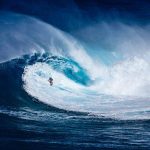Wherever there are waves breaking, you will find surfers riding them. The concept is simple- all you need is a breaking wave, a board, and a brave athlete and you can enjoy the sport.
Although surfing is commonly thought of as taking place in warm ocean water at locations such as Hawaii and California, surfers will go to any type of location in order to surf. This includes places such as Antarctica, where they brush the snow off their surfboards, as well as jungles and beaches in Southeast Asia.
In addition, surfers are not afraid to share the water with great white sharks in South Africa. Finally, they will even ride the giant tidal bore known as the “silver dragon” in China’s Qiantang River.
When a surfer sees a good wave, they will paddle quickly to catch it. Just as the wave is about to break, the surfer will jump from laying on their stomach to their feet, crouching on their board. The ability to stand up is a sign of an experienced surfer.
The surfer will ride the wave as it breaks towards the shore. As the wave falls and starts to lose power, the surfer has the option of exiting the wave by either turning their board back towards open water or simply lowering themselves back down to their board and paddling back out.
However, the force of the wave can also end the ride by crashing on or over the surfer. The surfer can be tossed above or below the wave and the process of paddling back out to the surf line begins again.
Waves
Surfing relies on the science of hydrodynamics, which is the study of water in motion. Oceanographers, ship captains, and engineers must all be familiar with hydrodynamics in order to understand how surfing works.
Surfers try to find waves called swells. Swells are reliable waves that originate from far away from the shore. Swells are caused by different types of winds or by stormy weather.
The first thing that determines the strength of a swell is the strength of the winds that form them. Swells can help predict how strong a storm is as it approaches land. Most storm systems that form far out to sea never reach land with much strength, but sometimes they do.
These storms arrive as hurricanes or typhoons. Hours before a hurricane approaches shore, large and frequent swells signal its arrival. Surfers have been known to ignore hurricane warnings and stay out on stormy beaches because the swells are so frequent and strong.
Fetch is a term that describes how far the wind has blown over open water, which is why ocean swells are usually much stronger than lake swells.
Not all waves are swells, however. Most are smaller, more unpredictable waves, called wind waves. Swells are a type of wind wave (they are caused by wind), but the term usually refers to waves caused by the wind with a shorter fetch. Wind waves have more chop than swells.
Chop is the amount of short, irregular shifts in wave formation. Choppy water can be dangerous for surfers because the direction and strength of waves change from minute to minute.
Breaking Waves
Both types of waves must break in order for surfers to take advantage of them. If there is no wind, the waves will not break and the surfing conditions will be poor.
Surfers need a steady supply of waves that break in the same spot, which can only be achieved with moderate offshore wind.
The most important factor that determines the size of a wave is the underwater topography. The topography is the surface features of an area. The size of a wave can be affected by the underwater features of the sea floor.
Reefs, sandbars, and large underwater boulders cause waves to break predictably and are therefore known as surf breaks. Furthermore, ocean trenches and submarine canyons also play a role in determining how a wave will break.
When surfing, one must be aware of their surroundings and take into account things such as a kelp forest as it can cause a wave to break more slowly.
A wave breaks when the height of the wave becomes too much for the water at the base of the wave to sustain. This usually happens near shore as the water gets shallower near a beach. The shallower the water is, the more likely the wave is to break.
The region where the waves start to break is called the surf line. When a wave breaks, it crashes forward with the tips of the wave turning frothy and white. Sometimes, a wave will crash into another wave when it breaks.
Other waves will curl in on themselves and form a tube near the crest of the wave. This is considered the most desirable type of wave to surf by many surfers.
The four main types of waves are: (1) the Gravitational Wave, (2) the Electromagnetic Wave, (3) the Weak Force Wave, and (4) the Strong Force Wave.
Each type of wave has its own unique difficulties that must be overcome by experienced surfers.
Rolling Waves
The least familiar waves are the seiche waves. These waves are produced by a strong wind blowing across a lake. The wind pushes the water onto one shore of the lake. The water then sloshes back and forth until the wind dies down.
The most familiar waves to most people are the ones that break in a stable pattern. These are the kind of waves that surfers usually prefer. Rollers typically occur on flat, sandy shorelines. The rolling waves at Hossegor in France can reach heights of up to 20 feet.
The least familiar kind of waves are seiche waves. They are caused by a strong wind blowing across a lake. The wind pushes the water onto one shore of the lake. The water then sloshes back and forth until the wind dies down.
Dumping Waves
Waves that are the result of an abrupt change in seabed topography are more unpredictable. A steep underwater cliff or mountain can create dumping waves, which are usually only safe for experienced surfers because they can be very dangerous.
Dumping waves can force surfers deep beneath the water’s surface with a lot of force.
Dumping waves are caused by point breaks, which happen when a wave hits a point of rocky shore that juts into the ocean. Agadir, in Morocco, has a few strong point breaks.
Dumping waves can also occur when waves pass over a coral reef or rocky area and break. This can be dangerous for surfers if the wave dumps them onto the reef. However, reef breaks often result in some of the most rewarding waves.
For example, in Fiji there is a reef break called Cloudbreak that attracts many experienced surfers.
Surging Waves
The most dangerous waves are surging waves. They occur most often on steep or rocky shores. They don’t break as they near the shore like rolling or dumping waves. Instead, they break at the shore itself.
Surging waves are very dangerous because they can easilythrow surfers against the rock or reef.
surging waves = waves that are rising and breaking large storms = storms that are big and powerful surfers = people who ride on the surface of water on a surfboard far away = at a distance
Standing Waves
Standing waves are also known as stationary waves. They are constant and do not lose strength. The factors that contribute to these waves – the topography of the region, water flow, and wind patterns – do not change.
Waves created by artificial wave machines in landlocked areas are examples of standing waves. The first wave pool in the U.S. was established in 1969 in Tempe, Arizona.
Why Learning to Fall and Relax Is So Important to Your Surfing
If you’re not okay with falling, or taking risks, you’ll never improve at surfing. You have to be willing to try new things and work on small parts of your technique to understand your surfing better. Otherwise, you’ll never get that feeling.
Only a surfer knows the feeling of flow that comes from hitting the wave just right. You have to experiment with different techniques and learn to read the waves to get a sense for when you’ll be able to ride the wave smoothly.
So if you are stuck in this, you’re not improving, nothing will change unless you learn to fall and learn to relax in falling. It’s more about letting go than it is about the correct method to fall.
Groms Learn Faster Than Us Because It’s All Play
If you watch the young kids, they don’t seem to be afraid of falling. They just want to have fun and play around. They’ll keep trying new things and making small changes until they find what works for them.
When things are enjoyable, we tend to learn more quickly. This is why adults can sometimes have a difficult time learning, because they are scared to take risks.
It’s understandable to be cautious, but it’s important to be aware of this fact.
Viewing This From Other Sports
There is a more obvious risk involved in activities such as snowboarding, waterskiing, skating, and kite surfing, as opposed to surfing, since participants in those activities are more likely to hit a hard surface or the water at high speed while wearing equipment.
If you want to avoid getting hurt, you need to learn how to fall early on. Taking a few beatings early on will teach you this lesson quickly.
You first need to know how to progress and fall safely if you want to learn a new skating or snowboarding trick. However, most surfers just hope they can miraculously learn a maneuver and skip the phase of struggling and failing.
If you want to improve at handstands, you need to learn how to fall out of them safely.
The most important thing about surfing is learning how to fall so that you can stay relaxed and safe.
The Fear of Wiping Out
If you are stressed about riding the wave, you will manifest that stress in your surfing across the whole wave.
If you’re constantly running from fear, you’ll never be able to surf your best. You’ll be too stressed and anxious, which will prevent you from moving efficiently.
Worrying about getting injured can actually lead to getting injured.
When people skate or surf, they tend to be more cautious and watchful of the risks they are taking, which results in stiffer movements.
This is not efficient because you are fixated on the ramp or section and cannot look away, which is causing your perception of danger to increase.
Wherever you look is where you will go. If you stare down, you will project your body down.
If you stare at the ramp or wave, you may think it looks cool, but you’re more likely to fall or get hit. You need to look through to where you are going and not what is happening elsewhere.
How to Avoid Hitting Other Surfers
According to the author, if you want to avoid hitting another surfer, you should stop looking at them with fear.
Instead of looking at the waves, look away from them. Tell your body you want to go in the opposite direction, and send that signal to your board. You don’t have to be a good surfer to direct your board that way.
Even if you try to avoid them, your body language is still telling your board that you want to go that way.
So stop it and look away from the thing or person that causes fear. Look through to where you want to go, and move efficiently rather than in a panic.




